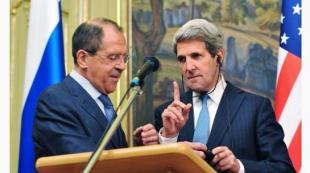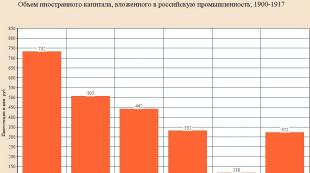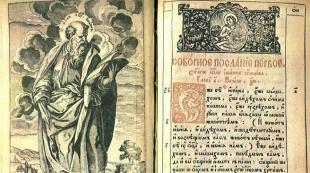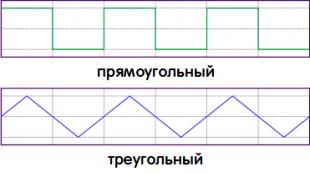Message on the theme of the first printer Ivan Fedorov 3. Ivan Fedorov short biography. "Apostle" and "Hourmaker"
Ivan Fedorov brief biography is set out in this article.
Ivan Fedorov short biography
Ivan Fedorov- one of the first Russian book printers, as well as an engraver, engineer, foundry worker. For some time he served as deacon of the church of Nikolai Gostunsky. He was teaching literacy. Graduated from Krakow University and had a bachelor's degree.
There is no exact date of birth, it varies from 1510 to 1530. After graduating from Krakow University in 1532, he met Metropolitan Macarius, who was close to Tsar Ivan the Terrible. Thanks to his petition, in 1550, work began on the construction of a printing house in Moscow. Fonts and equipment were selected with special attention. Fedorov was also involved in this case.
In 1564, the first Russian printed book, The Apostle, was published. By order of Ivan the Terrible, another printed book of a liturgical nature, The Book of Hours, was printed in two copies, which taught writing. The boyars and the higher clergy blamed Fedorov and his assistant Mstislavets, which forced them to leave Moscow.
Having settled in Zabludovo, they built a printing house at the expense of Khodkevich, where the Doctrine Gospel was issued in 1569. This book was a real masterpiece of printed art - the masterful finish and design was simply mesmerizing. The Psalter was also published there. Over time, Khodkevich closed the printing house, advising Fedorov to take up farming.
In search of a better fate, Fedorov travels to Lvov. With the assistance of the Lviv Brotherhood, he organized his own printing house. In February 1573, the first Lviv "Apostle" and "Primer" were printed - the first printed manual in Ukraine for teaching writing. The books were decorated with headpieces, engravings, carvings and coats of arms of Lvov and the author.
In 1575, he transferred the printing house in Lvov under the control of his son and entered the service of Konstantin Ostrozhsky. In Ostrog, he also founded a printing house with the assistance of the prince. It was here that an outstanding theological book, the Ostrog Bible, the first complete Bible in Church Slavonic, was issued in 1581.
Until the 15th century, painstaking important work was carried out in all monasteries - books were copied. Each new book was created from several months to several years. Everything changed in 1534 when Johannes Gutenberg invented the printing press. It took more than twenty years for the new technology to reach Rus'.
Ruled back in 1563 by Prince Ivan the Terrible. The great ruler wanted to keep up with Europe. So, at his command, on April 19, 1563, the first “printing house” in Rus' was opened. The famous monk Ivan Fedorov became the first printer. A month later, a printed book was published, which became the first published in Russian. It was called "Acts and Epistles of the Apostles" or more simply "Apostles". The book came out wonderful, a special two-color printing, invented by Ivan Fedorov. It is decorated with 22 initial letters, 46 ornamental headpieces with elements of cones and vines. The author's idea that the book looks like a handwritten one according to the old traditions was a success. 
Drukar from God
Few people know, but we owe the appearance of spaces between words to the first printer Ivan Fedorov. Previously, all words were written together. Only sentences were separated by dots. In addition, he introduced some new words and even letters. We still use the alphabet invented in the distant 15-16 centuries. Ivan Fedorov possessed encyclopedic knowledge, spoke and wrote fluently in several languages, and believed that his vocation was to bring spiritual and intellectual enlightenment, knowledge and books to the people, to teach people to read and write and lead a righteous life.
The fruits of the labors of the righteous and printed
However, Fedorov did not work on the books himself; Peter Mstislavets was his assistant and friend. A year after the "Apostles", the Watchmaker saw the light of day. Some time later it was republished. Envy and persecution from supporters of the old traditions were too great. The monks did not want to recognize book printing; by their deeds they managed to escape the first printers. But they did not stop their work. In 1568 the Doctrine Gospel was published. Then there were the Four Gospels, the Psalter, the Psalter with the Book of Hours, the ABC, the Psalter and the New Testament. The last was the Ostroh Bible. It is also the first complete Bible in Church Slavonic.
The great contribution of Ivan Fedorov and Peter Mstislavets to the spiritual and cultural development of the Slavic peoples was appreciated by the descendants. Monuments were erected in their honor, a holiday was founded.
To use the preview of presentations, create a Google account (account) and sign in: https://accounts.google.com
Slides captions:
Literary reading. Theme of the lesson: "Printing Pioneer Ivan Fedorov."
Book-teacher, Book-mentor, Book-close comrade and friend. The mind, like a stream, dries up and grows old, If you let the book out of your hands. Consider such a dwelling as poor, Where all the concern is to fill the stomach, Where high-calorie tasty food Does not recognize spiritual food. Book-adviser, Book-scout, Book-active fighter and fighter, Book-imperishable memory and eternity, Satellite of the planet Earth, finally…
Manuscripts of Ancient Rus'.
The very first printed book appeared in our country in 1564.
In Rus', the initiator of printing was Ivan. He went down in history as the pioneer printer Ivan Fedorov, although in some of the books he printed he signed as Ivan Fedorovich Moskvitin. The printing press was then a matter of national importance, and no one dared to engage in printing without the king's instructions. After all, Ivan the Terrible then ruled - a terrible and cruel king. On the other hand, the tsar understood the significance of the book and, having decided not to lag behind Europe, he ordered the construction of the Sovereign's Printing House. The church deacon Ivan Fedorov, the future first printer, became its leader.
The first printed book, which indicates the name of Ivan Fedorov (and Peter Mstislavets who helped him), was "Apostle", work on which was carried out, as indicated in the afterword to him, from April 19, 1563 to March 1, 1564. This is the first accurately dated printed Russian book.
Vocabulary work. (p.10-12). STAFF - a long and thick cane. DRUKAR - typographer, printer. FALSE - False accusation.
LESSON SUMMARY. What was the first printer's name? In what year was the first book published in our country?
Reflection.
Homework. Prepare a short retelling of the first books. Expressive reading or story about Ivan Fedorov.
On the topic: methodological developments, presentations and notes
This methodological development was compiled according to the teaching materials "School of Russia" for the 3rd grade, the topic is "First Printer Ivan Fedorov", there is a presentation in development and there is a link to a fragment from a historical film ...
Class hour "Printing Pioneer Ivan Fedorov"
Development for a class hour on the topic "Printing Pioneer Ivan Fedorov". Contains a summary of the lesson and a computer presentation. Grade 3....
Ivan Fedorov (between 1510 and 1530 - 1583), born Ivan Fedorovich Moskovitin, is one of the first distributors of book printing in Russia and Ukraine. He published the first dated printed book in the Russian kingdom called "Apostle", founded a printing house in the Russian province of the Polish kingdom.
Origin
The exact place of birth of Ivan Fedorov and even the date of his birth are not known to researchers. They can only make assumptions based on fragmentary information found in various historical documents.
So, there is a great difference in the years in which a book printer could be born, but historians still lean closer to 1510. As for the homeland, Fedorov himself calls Moscow his fatherland. The conducted studies of its typographical mark suggest that it could be related to the ancient Belarusian gentry family of Ragoza. A specific place is most often called the Dzerzhinsky and Vileika districts of the Minsk region.
According to the versions of some scholars, Ivan Fedorov was enrolled as a student at the University of Krakow and recorded as "Johannes Theodori Moscus" and studied there from 1529 to 1532. This is very likely to be true, especially given the coincidence of names.
In the early 1530s, Fedorov served under the Moscow Metropolitan Macarius as a deacon.
The device of the Moscow printing house
When in 1552 work began on the organization of the first printing house in Moscow, Ivan Fedorov became an apprentice with a master who arrived from Denmark. In the next few years, several copies of books were released that did not include any imprint. But the main thing was yet to come, it required a long preparation.
In 1564, the Moscow "Apostle" finally saw the light. It contained the names of the creators: Ivan Fedorov himself and Peter Mstislavets, who helped him in his work.
Despite the organization of the Printing House in Moscow and the successes achieved by the first printer, after some time he unexpectedly left Moscow and went to the Grand Duchy of Lithuania.
The official version says that this happened due to the dissatisfaction of the book scribes, who were afraid of being left without work and even burned down the printing house. However, modern researchers see other possible explanations. For example, by the years described, Fedorov had become a widow and, according to the rules of the white clergy, had to take monastic vows. For some reason, he did not do this, so he was removed from printing activities.
Fedorov himself writes that he was forced to leave the Fatherland by the anger and envy of state leaders and priests.

Lithuania
Arriving in the Principality of Lithuania, Ivan Fedorov settled in the estate of Hetman Khodkevich, who at that time had already created a printing house and needed specialists to establish its work. For several years everything went well, but soon the hetman suddenly decided that he no longer needed a new enterprise, and closed it.
Fedorov strove to continue doing what he loved. However, for this he needed substantial funds. Having moved to Lvov, with the voluntary help of the townspeople, he managed to establish a new printing house. Despite the fact that many new books were published, things did not go very well, again the resistance of interested parties played a negative role. As a result, Fedorov had to sell his company.

The next place of residence of the first printer was the city of Ostrog, where he was invited by Konstantin Ostrozhsky. Here he published the "Ostroh Bible" ─ a magnificent edition in Church Slavonic.
End of life
Ivan Fedorov was famous not only for his attitude to the spread of printing. He was also engaged in casting cannons and even invented a multi-barreled mortar, which had interchangeable parts. It was with this discovery that he went to Europe, where he traveled to many cities, demonstrating it to interested people.
The trip turned out to be long and difficult, and by that time Fedorov himself was already quite a few years old. It is believed that it was the difficulties suffered that crippled the health of the inventor. As a result, on December 5, 1583, not far from Lvov, he died and was buried in the cemetery of the local St. Onufrievsky Monastery.
Ivan Fedorov became the first book printer in Rus'. He is also considered the founder of book printing in Ukraine, since it was this man who founded printing houses not only in Moscow, but also in Kyiv and Lvov.
Fedorov, according to most researchers, came from the Belarusian nobility, from a family that by the sixteenth century was rather little known and did not stand out in any way. The future creator of Russian printing studied at the University of Krakow, was part of the entourage of Metropolitan Macarius and even served as a deacon in one of the churches of the Moscow Kremlin.
It was Macarius who was one of those who contributed to the development of book printing in Rus'. It is possible that he recommended the young and highly educated Fedorov to Tsar Ivan IV, who ordered the opening of a printing house in Moscow in the 1550s.
As Ivan Fedorov himself wrote: "the tsar ordered to build a house from his treasury, where the printing business would be built."
The printing house organized by Ivan Fedorov produced books of religious content, the first of which was The Apostle (the liturgical part of the New Testament), published in 1564. The second book of the state printing house was The Clockworker, published in 1565.
Soon after his printing house began to produce books, Fedorov became involved in several conflicts. Typography in Rus' was met with hostility and it was believed that the sacred book should only be handwritten.
The patron of Ivan Fedorov, Metropolitan Macarius, died in 1563 and could not protect the Russian first printer. In the end, Fedorov and his friend and colleague Peter Mstislavets had to flee to the Grand Duchy of Lithuania, where Fedorov, again, was organizing the printing process.
He and Mstislavets are working on the Doctrine Gospel, a publication of gospel texts supplemented with commentaries and interpretation of complex and obscure points.
However, Ivan Fedorov does not stay in Lithuania either. Now Ukraine is waiting for him. He moves to Lvov, where he again organizes a printing house. In addition to Lvov, he has to work in the city of Ostrog, where he produces the first ever complete printed edition of the Bible in Church Slavonic, which went down in history under the name of the Ostrog Bible.
Before his death, he traveled to Europe, again visited Krakow, Vienna, Dresden. In addition to working on books, he spent a lot of time attending other technical issues: in particular, Ivan Fedorov dealt with issues of casting gun barrels.
The Russian first printer died in 1583. He was buried in the St. Onufrievsky Monastery in the city of Lvov.









